Hey there! I’m Scott from the top four of last year’s Great Designer Search 3. Welcome back to another installment of Deadly Designs, where we talk about Magic card design from an outsider’s perspective.
Last time we talked about new cards that could’ve been printed in Modern Horizons, but now it’s time to bring it back to a single-card discussion, specifically about one reefy boy.
You can’t spell “hUG of death” without “UG!”

There were a lot of surprisingly powerful cards that came out of the M20 Core Set, and Risen Reef is near the top of the list. But my question is: is it too good?
It’s easy to jump on an answer to that question. Something like: “No, of course it’s not too good, it dies to literally everything!” or “Yes, of course it’s too good, just look at it!”
But what I want to do is break down the card by (1) comparing it to other similar cards, and (2) creating some new cards as a thought exercise. So let’s get started!
#1. Comparing Risen Reef to Other Cards

Beast Whisperer is an obvious comparison to Risen Reef: they both essentially draw cards for playing more creatures. However, Risen Reef compares extremely favorably to it.
Risen Reef only costs three, triggers off itself, and triggers off tokens too, turning cards like Scampering Scorcher into Ancestral Recall. Beast Whisperer may trigger off any creature, and be a single color, but in a format with plenty of Elementals and good mana fixing, those are basically non-issues.
Lastly, one thing to mention is that Beast Whisperer (and all of the other comparison cards) simply “draw cards,” while Risen Reef puts the cards into your hand or onto the battlefield. Not only is this better, but it also gets around Narset’s passive ability, making Risen Reef a much more appealing choice.
Overall, Beast Whisperer is laughable to think about playing while Risen Reef exists.
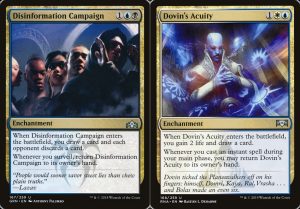
How does Risen Reef compare to some other three-mana draw engines?
Dovin’s Acuity and Disinformation Campaign both trigger off themselves, just like Risen Reef, and Disinformation Campagin can put you up two cards if your opponent discards one. But unfortunately they fall short in one important way: you have to keep paying mana for the extra triggers by recasting the enchantments. With Risen Reef, once it’s out, you don’t have to pay anything extra.
Even though Risen Reef is more fragile than the enchantments since it can be killed more easily, its explosiveness and efficiency leaves these two molasses-speed engines in the dust.
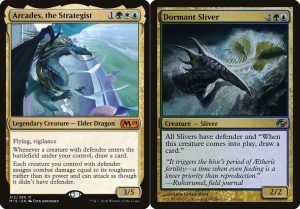
What about some other tribal-themed draw engines?
Again, the comparisons aren’t great. Arcades costs four, requires three different colors, and doesn’t trigger off itself. Also, playing creatures with defender is a much bigger requirement than playing Elementals. Your walls will not do anything except sit there and stare at you without Arcades (or High Alert), whereas the Elementals you play alongside Risen Reef can still attack just fine without it.
The same thing goes for Dormant Sliver. Even though Slivers are a much more supported tribe than Elementals, the defender drawback is huge. You’ll have to find some way to win without attacking as long as Dormant Sliver is on the battlefield.
These two seem to know that giving such a huge benefit to a tribe requires a similarly huge drawback, which Risen Reef doesn’t really have.

Compared to Risen Reef, these two are just a joke.
Guardian Project costs four, does nothing by itself, and requires a huge deckbuilding restriction. Kiora can slot into more decks with her hybrid cost, but she does little by herself, whereas Reef will always draw you at least one card.
I remember when Kiora and Soul Diviner were seen as a value combo, with the Soul Diviner removing a counter from Kiora to draw a card, then her untapping the Diviner to draw another. But why bother with any of that cuteness when you can just play Risen Reef and let the card advantage waterfall without any added effort?

In the end, Risen Reef destroys the other card advantage engines. But does that make it “too good?” Let’s look at it another way.
#2. Thought Experiment Cards
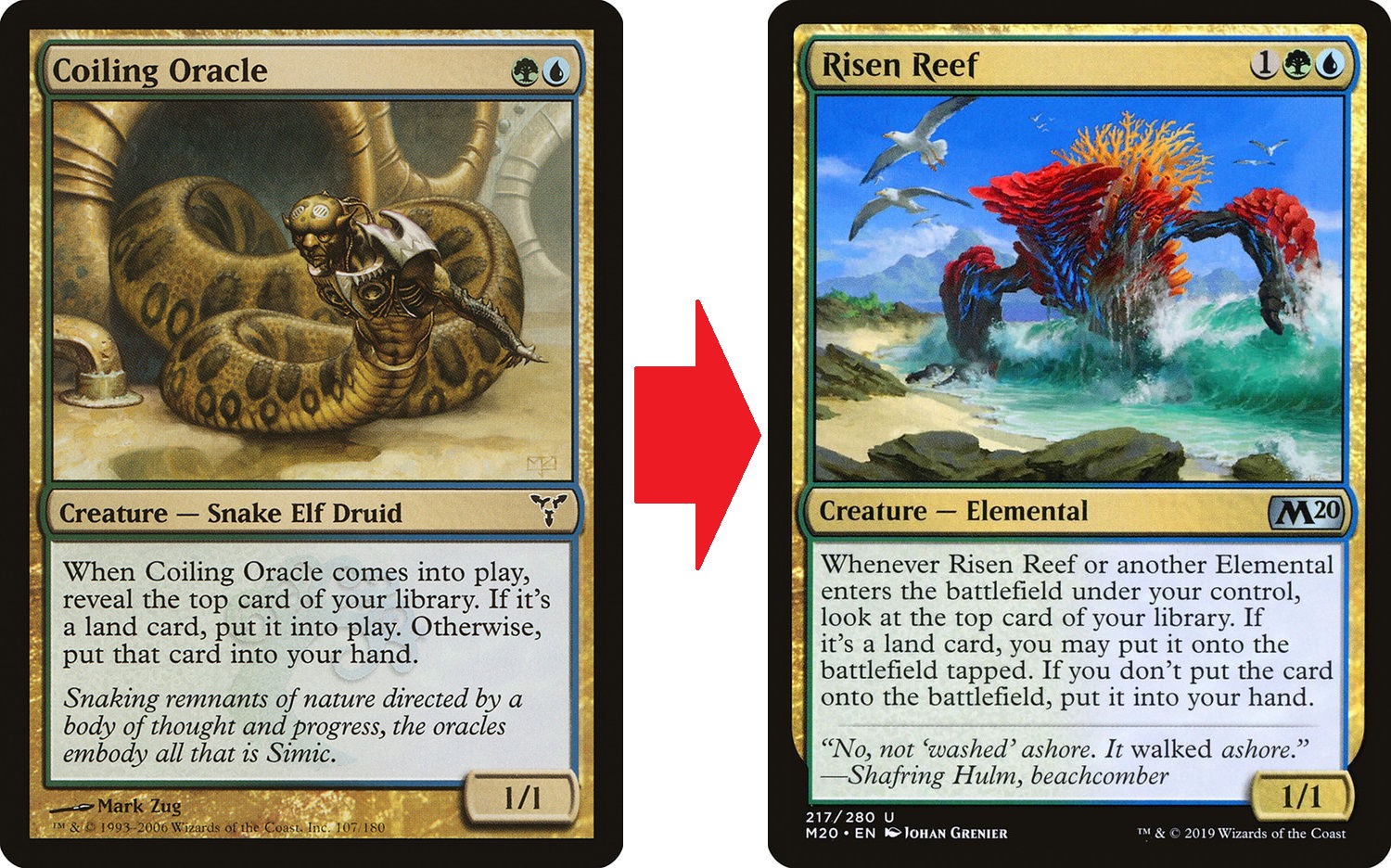
There’s a formula for making Risen Reef: take a good two-drop, add a mana, and then have it trigger whenever another creature of the same type comes into play too. It’s essentially what happened with Coiling Oracle to bring about Risen Reef.
So, using this “Risen Reef Formula,” let’s see what some other versions might look like:
(For this exercise we won’t be changing the creature types, but they could be whatever you’d like.)

Already starting off with a doozy. Just by itself, Viashino Pyromancer is a good card, but granting its burn ability to every Wizard you play (or whatever creature type it’d be) is super strong.
There aren’t a ton of Wizard token producers (Kasmina is the only one in Standard), but if there were a few enablers released along with it like Risen Reef got in M20, it would be hard to play any other version of mono-red besides mono-wizards.
Keeping this kind of ability at four mana — like Purphoros, God of the Forge — feels like a good idea.
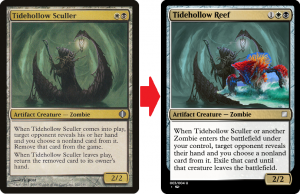
Now I’m starting to feel a little sick. Similar to Elementals before M20, Zombies have existed on the fringe of playable, but something like this would likely push them over the edge.
Sure, all it would take is one removal spell to tumble the dominoes of all the Zombies exiling things, but seeing how well Kitesail Freebooters chain into each other in Modern, I can imagine that this would do something similar.
It’s also important to note that “Tidehollow Reef” has a limit to how good it is. If your opponent has no cards in hand, then it does nothing, whereas Risen Reef will always draw you more cards. This means that Risen Reef potentially compares favorably to this hypothetical, terrifying card.

Something like this would likely make me want to stop playing Magic… because I literally wouldn’t be able to cast any more spells.
Obviously Humans is a hugely-supported tribe, and something like this is broken beyond belief, but it just shows how using the “Risen Reef Formula” can lead to some crazy stuff.
Hey! You stay away from those cards, Reef!
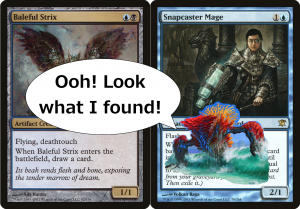
Overall, using the “Risen Reef formula” with other cards seems to break them in half. And not only that, but it’s not even clear if they’re better than Risen Reef already is.
So was Risen Reef a mistake?
Looking at all the evidence, it seems like Risen Reef is too good.
Something like one of these alternate versions might have been better. The left one only triggers on other Elementals, and the right one only triggers once per turn. Both still get value, scale well, and cost three like R&D wanted, but might be more reasonable.

The left one is like a Wirewood Savage that can trigger other copies of itself, and the right one is like Dark Confidant: powerful, but only if it survives a turn cycle.

However, is Risen Reef a “mistake?” I don’t think so.
I think that cards like Teferi and Narset are mistakes because they stop your opponent from playing the game and from interacting. But Risen Reef doesn’t do that. Risen Reef is likely too efficient, but it doesn’t stop your opponent from playing their deck.
One thing that is troubling about Risen Reef is that it’s both value by itself and a value engine at only three mana. Even if you kill it the turn it comes down, you’re still down a card, but if you don’t kill it right away, then it’s basically game over. Even if you deal with it immediately, you’re still behind, but if you don’t, then you’re dead.
Cards that can come down early, provide value immediately, and essentially win the game if left unchecked have historically become format pillars.

So what do you think? Is Risen Reef a mistake? Will it become a pillar of the new Standard or perhaps even in Modern someday?
Let me know, and until next time, stay reefy!
In the meantime, feel free to say hi on Twitter or on Twitch!
